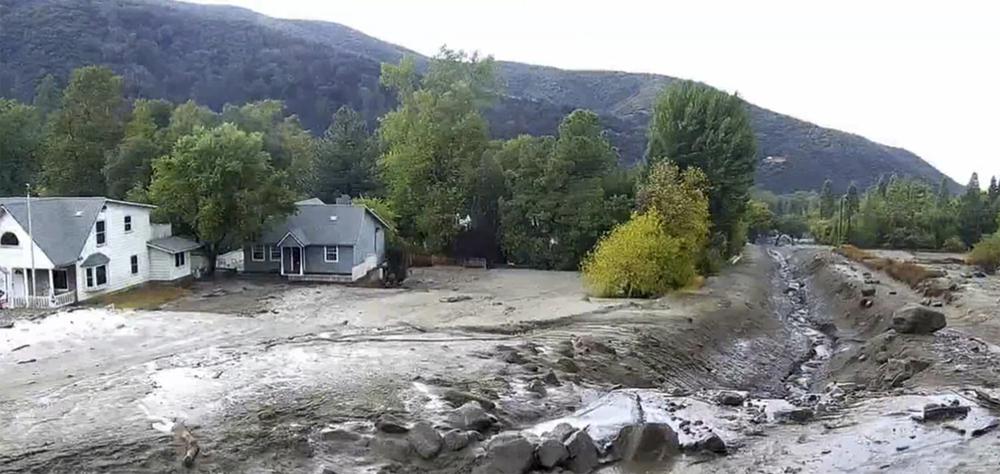Cleanup efforts and damage assessments were underway Tuesday east of Los Angeles after heavy rains unleashed mudslides in a mountain area scorched by a wildfire two years ago, sending boulders across roads, carrying away cars and prompting evacuations and shelter-in-place orders.
Firefighters went street by street to make sure no residents were trapped after mud flows began inundating roads Monday night near the community of Forest Falls. Eric Sherwin, spokesperson for the San Bernardino County Fire Department, said crews hadn’t found anyone who needed to be rescued and no one was reported missing.
Multiple homes and other structures had varying levels of damage, Sherwin said, including a commercial building where the mud was so high it collapsed the roof. Rocks, dead trees and other debris surged down slopes with astonishing force in Forest Falls, Oak Glen and Yucaipa, he said.
“We have boulders that moved through that weigh multiple tons,” Sherwin said. “It could take days just to find all the cars that are missing because they are completely covered by mud.”
Social media video from Oak Glen showed a torrent of mud racing down a hillside, across a road and into a restaurant parking lot.
Perla Halbert had been out of town and returned to her Oak Glen home late Monday to find the driveway covered with a few inches of mud. Her family stayed the night with family members and returned after first light to discover several feet of mud and a fence washed away.
“I’ve never seen anything like this before,” Halbert said. “If you try and take two steps, you get submerged. You just get stuck.”
Her husband went to buy boots and coveralls before trekking through the muck to assess the damage.
“There’s lots of rocks and so much mud. But hopefully the house itself is OK,” she said.
Nearly 2 inches (5 centimeters) of rain fell on Yucaipa Ridge. Concerns about more thunderstorms Tuesday prompted authorities to keep about 2,000 homes in the San Bernardino Mountains communities under evacuation orders.
For some homes in Forest Falls, it was too late to evacuate Monday and residents were told to shelter in place through the night because it was safer than venturing out.
The rains were the remnants of a tropical storm that brought high winds and some badly needed rainfall to drought-stricken Southern California last week, helping firefighters largely corral a wildfire that had been burning out of control about 20 miles (32 kilometers) south of the mudslides.
The mud flows and flash flooding occurred in parts of the San Bernardino Mountains where there are burn scars — areas where there’s little vegetation to hold the soil — from the 2020 wildfires.
“All of that dirt turns to mud and starts slipping down the mountain,” Sherwin said.
One of the 2020 blazes, the El Dorado Fire, was sparked by a smoke device used by a couple to reveal their baby’s gender. A firefighter died and the couple was charged with involuntary manslaughter.
About 40 miles (64 kilometers) west, Cal State San Bernardino reopened Tuesday, a day after the campus was closed when several buildings were flooded during heavy rains.
The mudslides came after a week that saw California endure a record-long heatwave. Temperatures in many parts of the state rocketed past 100 degrees Fahrenheit (38 degrees Celsius), and pushed the state’s electrical grid to the breaking point as air conditioners sucked up power. The Fairview Fire in Southern California and the Mosquito Fire burning east of Sacramento broke out and raged out of control.
The tropical storm aided crews battling the Fairview Fire about 75 miles (121 kilometers) southeast of Los Angeles. The 44-square-mile (114-square-kilometer) blaze was 62% contained by Tuesday. Two people died fleeing the fire, which destroyed at least 30 homes and other structures in Riverside County.
The Mosquito Fire has grown to 78 square miles (200 square kilometers), with 18% containment, according to the California Department of Forestry and Fire Protection. While crews were able to take advantage of cooler temperatures and higher humidity to strengthen control lines, more than 5,800 structures in Placer and El Dorado counties remained under threat, and some 11,000 residents were under evacuation orders.
Smoky skies from wildfires in many areas of the West caused air quality to deteriorate Monday, with dangerous levels of particulate pollution detected by government and private monitors in portions of eastern Oregon and Washington, Northern California, central Idaho and western Montana. In some areas, people were told to avoid all outdoor activity until the pollution cleared.
In Washington, fire officials scrambled to secure resources for a blaze sparked Saturday in the remote Stevens Pass area that sent hikers fleeing and forced evacuations of mountain communities. As of Monday, the Bolt Creek Fire was 2% contained and had scorched nearly 12 square miles (31 square kilometers) of forestland about 65 miles (104 kilometers) northeast of Seattle. A larger incident management team and additional fire crews were slated to arrive Tuesday, officials said.
In Oregon, evacuations orders were eased near the 135-square-mile (349-square-kilometer) Cedar Creek Fire, which has burned for over a month across Lane and Deschutes counties south of Portland. Firefighters were protecting remote homes in Oakridge, Westfir and surrounding mountain communities. Sheriff’s officials warned people to remain ready to leave at a moment’s notice should conditions change.
Scientists say climate change has made the West warmer and drier over the last three decades and will continue to make weather more extreme and wildfires more frequent and destructive. In the last five years, California has experienced the largest and most destructive fires in its history.
(AP)












One Response
Now I see and understand what are some of the words in my morning prayers……good job Earth Wind and Fire……didn’t think this task was present…..